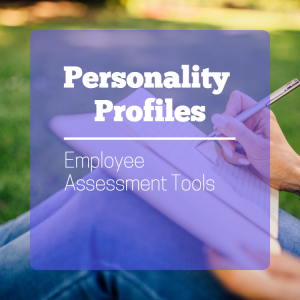 How well do you know your employees? Use personality profiles as fun and simple employee assessment tools.
How well do you know your employees? Use personality profiles as fun and simple employee assessment tools.
When I think of personality quizzes, those fun little tests all over FaceBook and Twitter that make procrastinating at work a breeze, are what come to mind. While the “Which Starbucks Drink Are You?” personality quiz was fun, and it certainly might help someone get to know my personality, it wouldn’t be very useful as an employee assessment tool.
Recently my friend was telling me about a personality test he took that was very useful in the business world. He just started a new job as a financial advisor and as part of his onboarding training, a personality profile was conducted on each new employee. Knowing the personalities and behavior traits of those who you are working with is important in any business, but especially in an environment where you are working closely with others.
To get to know everyone, his office used a simple 10-minute online questionnaire called the DISC profile. This test measures the observable behavioral tendencies of an individual rather than the employee’s internal preferences that are usually measured with other personality profile tests. Behavioral style refers to a person’s natural way of doing things and how they interact and communicate with others.
How it Works
According to the website, “the DISC model is a very simple four-quadrant framework used to articulate the common ways that all human beings tend to act and communicate.” DISC stands for dominance, influence, steadiness, and compliance.
Here’s an infographic that goes in depth about the model:
What Does it Do?
Everyone has a different personality and will therefore communicate and interact in a different way. Communication is a two-way street – how we send and how we receive messages matter. For success, employees need to be able to effectively communicate with each other and with customers or clients. Using the right employee assessment tools, you and your team can identify their personal communication style, familiarize themselves with the styles of co-workers, and predict the communication style of customers.
Dominance
The ‘D’ in this model stands for how you approach problems and challenges. If someone takes a direct approach to problems, they are considered to be more dominant. Knowing who the dominant employees are on your team is useful for group dynamics, task assignments and determining promotions. Someone who takes 10 minutes to tell a story might have a difficult time working with someone who gets straight to the point.
Influence
The ‘I’ stands for how you interact with others and attempt to influence people. Everyone can think of someone they know who is a natural leader. This person enjoys social interaction when problem-solving, and is generally optimistic about things. Contrasting this is the low ‘I’ employee who feels more comfortable with a logical approach to problem-solving and generally sticks to factual interaction.
Steadiness
The ‘S’ stands for how you respond to the pace of the environment. Personally, I do not care for change – I would prefer a steady environment with consistency. I would be high on the ‘S’ scale because of this trait. However, someone who actively seeks out change and thrives in a fast paced environment would score very low in the ‘S’ category. Employees who are supportive of change can be useful for times when a company wants to expand and send someone to a new location. It is important to identify who those people are for when you need them.
Compliance
Finally, the ‘C’ in DISC stands for how you respond to rules and regulations set by others. You are considered high on the ‘C’ scale if you rely on rules and regulations, and tend to be a cautious individual. Those who are low in this category are less likely to follow rules and will attempt to make their own rules and guidelines. These people are usually described as stubborn and independent.
Why Does it Matter?
Using personality profiles as employee assessment tools can improve employee engagement and increase productivity. People who communicate effectively and work well together are more likely to succeed than those who are unfamiliar with their co-workers. In the case of my friend, it has helped him to communicate more effectively with clients. Having an idea of their behavioral traits he is able to tailor his business approach in ways they will be more receptive to. For example, if he meets with a client who is a low ‘I’, he would open the meeting with facts and statistics rather than a joke. The DISC profile is just one of many helpful employee assessment tools. For more ideas, check out these 8 fun employee assessment tools for your office. Used in conjunction with other employee assessments, behavioral and personality profiles can be a useful resource.
Follow-up with your team after assessments and evaluations using Ving. The Ving app helps you reach out to employees in an interactive and meaningful way. Ving gives you real-time data so you know exactly who has interacted with each portion of your message, get your free trial today!
Download FREE Engagement Checklist






Leave a Comment